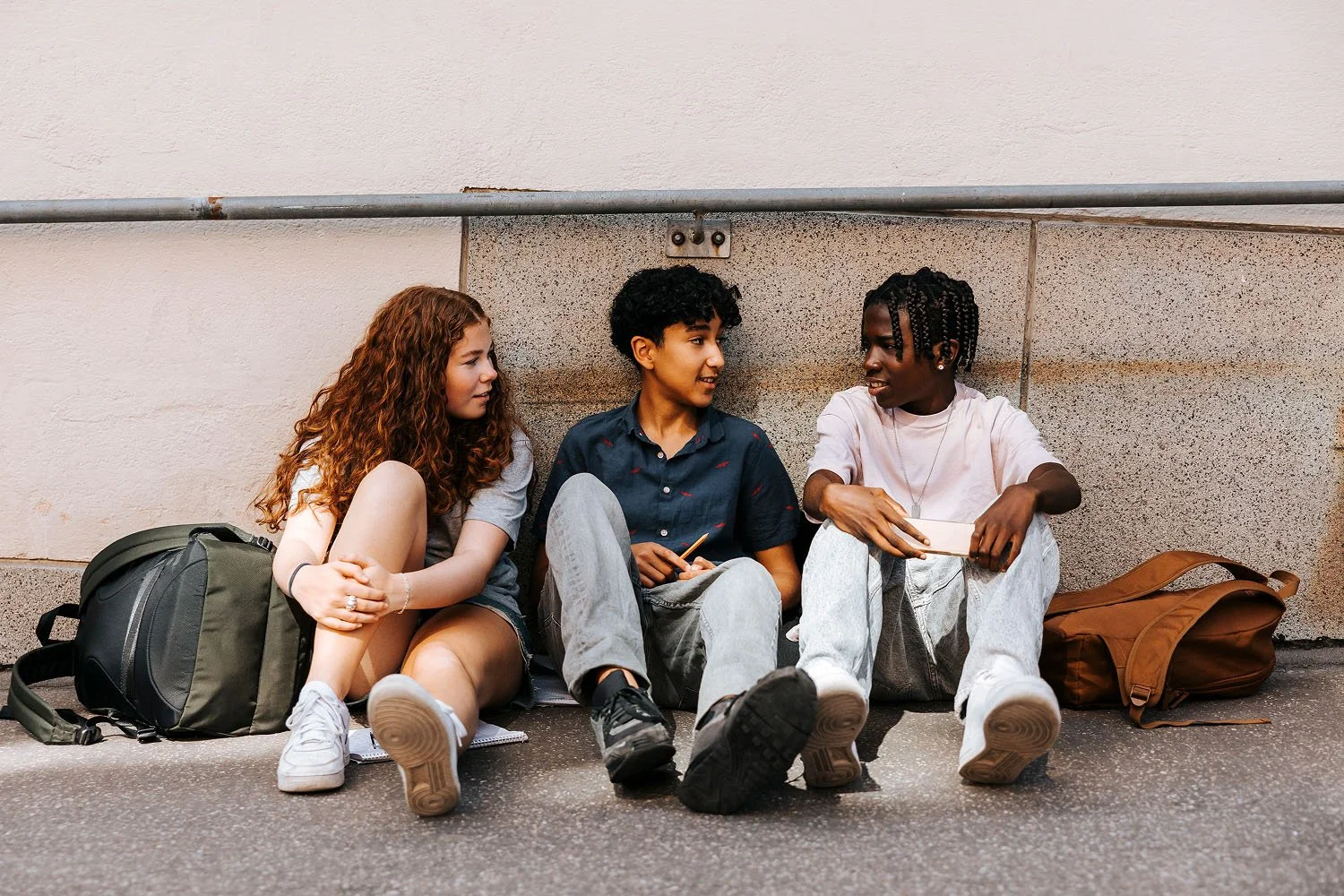Here's how to make friends at school (even if you’re shy)

Clinically reviewed by Dr. Chris Mosunic, PhD, RD, MBA
Not sure how to make friends at school? Learn why it can be hard sometimes, and 10 low-pressure ways to connect — even if you’re shy, new, or just feeling stuck.
Does this sound familiar? You walk into the cafeteria or slide into your seat in a lecture hall, and that sinking feeling hits: You’re not sure where you belong. Around you, it seems like everyone else has already found their group — the people they laugh with between classes, sit beside at lunch, and text during a boring lecture. You, on the other hand, are still scanning for an opening, not sure how or when to jump in. Maybe you hover nearby, hoping for a natural moment. Maybe you retreat to your phone, pretending you’re fine. But deep down, it feels isolating.
This scenario is far more common than most people admit — and it doesn’t just happen in high school or college. Whether you're starting middle school, returning to school as an adult, or shifting into a new program, making new friends can be surprisingly tough. Despite being surrounded by people, forming real, meaningful connections can feel overwhelming, especially if you’re shy, introverted, or out of practice.
But connection doesn’t require you to be the most outgoing person in the room. In fact, it often starts quietly — with a shared glance of uncertainty, a simple, “Hey, is this seat taken?” or a small moment of kindness. If making friends at school feels hard, it’s okay — and it doesn’t have to stay that way. Let’s explore why it can feel so difficult to break in, and real-world strategies for building friendships that feel authentic, even if the first step feels daunting.
Why making friends at school can feel hard
It’s easy to assume that making friends in school should just happen naturally. After all, you’re often surrounded by people who are around your age or who share your interests. Still, these commonalities don’t always lead to connection.
Here are five reasons it can be hard:
Some people may already have their circles: If you’re starting a new school, it can be tricky to make connections if everyone else is already part of a friend group.
It’s hard to know where you fit: With cliques and unspoken rules, figuring out how to engage with others can be exhausting.
Social risks feel magnified: Saying hi or sitting next to someone new can feel risky, especially if you’ve been rejected before or are feeling shy.
You might be juggling other transitions: Starting at a new school, adjusting to a different schedule, or managing mental health challenges can all impact your ability to socialize.
Friendship pressure is real: You might feel like you need to “fit in,” which can take a toll on your mental health.
How to make new friends at school: 10 tips to build connections
When it comes down to it, friendship is all about connection — and that can start in small ways. Whether you strike up a conversation on the bus or flash a smile to a classmate in the library, you’re putting yourself in a position to meet future friends.
Here are 10 small ways to build a connection.
1. Start with people you see regularly
Take note of the people who are in your classes, and give a nod or wave when you pass them in the halls. Over time, small gestures like this can turn into real conversations.
Try this: Chat with your classmates before the teacher begins their lecture. You might ask how their weekend was or even if they want to partner with you on a project.
Read more: How to make & keep friends as an adult: 10 ways to connect
2. Use your environment as a conversation starter
Small talk is a great way to start a deeper conversation. Try commenting on something you’re both experiencing, like the classroom temperature or the possibility of a pop quiz. These shared details can create an easy in.
Try this: “I can’t believe how freezing it is. Who needs a jacket in August?!” Showing off your personality can let them know it’s safe for them to do the same.
3. Join a club, activity, or group
Sign up for a club or activity where you’ll see the same faces on a regular basis. Shared experiences can help you build connections naturally.
Try this: Before joining a club, be honest with yourself about what you love to do. You’ll have more fun, and you’re more likely to meet like-minded people too.
Read more: How to be yourself: 14 ways to stay true to you
4. Aim for one solid connection over many
You don’t need to be part of a group right away. Meaningful one-on-one friendships are just as important. Look for someone who seems kind or shares your sense of humor.
💙 Get in the mindset to make new connections by listening to the Meaningful Practice for Meaningful Friendship series.
5. Show interest — without overthinking it
Ask people questions about themselves without prying. Keep it simple: “What type of music are you into?” or “What do you like to do after school?” It’s nice to make someone else feel seen.
Try this: If remembering names is hard for you, try repeating it back: “Nice to meet you, Sarah,” or, “Hey, Michael!” This can help you slowly lock it into your memory.
Read more: 20 question games to help you get to know anyone better
6. Take the pressure off being “interesting”
You don’t have to be the funniest person in the room. Most people are just looking for someone who is kind, who listens, and who doesn’t make them feel judged.
Try this: Instead of focusing on being interesting, focus on being interested. It’s less exhausting, and it builds a real connection faster.
💙 Practice building the skill of Curiosity about those around you during this meditation with Tamara Levitt.
7. Offer small invitations
Once you’ve chatted with someone a few times, invite them to something low-key, like walking to class or sitting together at lunch. That’s quality time too!
8. Look for other people who seem open
Look for cues that someone is open to conversation. Maybe they’re sitting alone, but scanning the room. They might even be waiting for someone like you to say hi first.
Try this: When you’re at lunch, put down your phone and make eye contact with people who look friendly. This lets them know that you’re also open to being approached.
9. Let it be awkward
Making friends can be difficult. When you say something awkward or endure what feels like an endless silence, try not to spiral. It happens to everyone.
Try this: Reframe these moments in your brain as proof that you’re trying — and that’s a win.
10. Follow up and stay consistent
If you’ve bonded with someone, try to keep the connection going. Say hi the next day or bring the conversation back to something you’ve already discussed. This is how people move from strangers to actual friends.
Try this: Text a friend about something interesting or funny they said. You could reach out and say, “I'm still laughing at that joke you made in class yesterday.” This shows that you care.
How to make friends at school FAQs
How long does it usually take to make real friends at school?
Every person makes friends at a different pace. For some, connection happens quickly, but for others, it unfolds over months of conversations and shared experiences.
What matters is finding the right people — the ones you feel comfortable enough to open up to. That takes time.
Is it harder to make friends in high school or college?
Making friends in high school and college can be hard in different ways. In high school, friendships often depend on routines you don’t control, like who you sit near and who ends up in your classes. This can be comforting, but also limiting.
In college, you have more freedom. This means there are more chances to meet people with similar interests, but there’s also more pressure to initiate. Neither setting guarantees friendship, but both offer opportunities if you stay open and patient.
What are the signs someone might want to be friends?
Most people show signs that they want to be friends in small ways. If someone responds positively when you talk, initiates a conversation, or chooses to sit near you, there’s a good chance they might want to be your friend.
Other good signs that someone is open to connection are laughter, eye contact, and sharing personal details. In general, friendship is typically built through mutual interest — little by little.
What’s the best way to start friendly conversations at school if I’m shy?
If you’re shy, a good way to start a conversation is to stick to shared topics that don’t require deep vulnerability right away. You could simply ask about the homework or what they thought of a recent test.
Compliments also go a long way. If you like their shoes, let them know. If you like how they doodle in their notebook, tell them. Also, remind yourself that if the conversation doesn’t go far, that’s okay. All you can do is try.
How do I make friendships that last?
Typically, lasting friendships come from mutual care and consistent effort. What makes a big difference is regularly following up. Reach out after a good conversation or invite someone to something you’re interested in.
Also, pay attention to what your friend is going through, and then check in when it matters. Lasting friendship is about showing up when it counts, and also being real with each other along the way.
Calm your mind. Change your life.
Mental health is hard. Getting support doesn't have to be. The Calm app puts the tools to feel better in your back pocket, with personalized content to manage stress and anxiety, get better sleep, and feel more present in your life.





